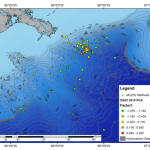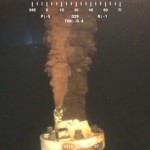![]() Blowouts and the subsequent dispersion of oil and gas in deep and shallow water differ immensely. In shallower waters, expelled gas will contribute to the buoyancy of the plume, which quickly rises to the surface. The rising gas bubble plume and the water it traps govern the size and shape of the resultant slick.
Blowouts and the subsequent dispersion of oil and gas in deep and shallow water differ immensely. In shallower waters, expelled gas will contribute to the buoyancy of the plume, which quickly rises to the surface. The rising gas bubble plume and the water it traps govern the size and shape of the resultant slick.
When a blowout occurs at great depths, colder temperatures and high pressures cause the formation of solid, ice-like methane hydrates. Thus, deepwater blowouts produce plumes that are less buoyant. If the water column is stratified with different densities of water masses, the rise of the plume may terminate. Even with small density gradients in the water column the plume could be trapped. Oil from a deepwater blowout may finally arrive at the  surface due to the individual buoyancies of oil droplets. Thus, the resulting oil slick from a deepwater blowout can only be predicted by knowing both the distribution of different size oil droplets and the local current regime.
surface due to the individual buoyancies of oil droplets. Thus, the resulting oil slick from a deepwater blowout can only be predicted by knowing both the distribution of different size oil droplets and the local current regime.
Because of these complications Johansen in 2003 stated “Modeling of deep-water releases of gas and oil is a demanding task that implies conventional plume theory in combination with thermodynamics and mass transfer calculations.” In other words, modeling a deep-water plume, requires the combination of multiple complex theories and equations. “ In total, without major modifications, blowout models derived for shallow to moderate water depths can be expected to produce unrealistic predictions of plume behavior and surface spreading when applied to blowouts from deep-water.”
The retention of the plume in deepwater, and the complicated dynamics governing it, was exemplified in 4 experiments conducted in 2000 at 840 meters in the Norwegian Sea. A gas and oil mixture was pumped to depth and released into the water. The total volume of oil at the surface estimated from aerial surveys was 78% smaller than that released at depth. Johansen’s models of the experimentally produced plumes were generally in good agreement but required multiple model additions including: modeling bubble instability, an understanding of dissolved gas saturation condition necessary for sustained hydrate formation, maximum droplet rise velocity, a first order decay model to account for the loss of surface oil due to natural dispersion and evaporation, and the empirical sized distribution of droplets. The take home point…the already complex models required more complexity.
Johansen recommended in 2003 that deepwater plume models needed enhancement by incorporating more information on currents and stratification, gas behavior, and hydrate formation.
In relation to the BP oil spill, perhaps some points should be stressed.
- Much of the oil from the Deepwater Horizon blowout is not at the surface but residing deep in the water column, i.e. we are only seeing the tip of an oily iceberg.
- The retention of the plume in deepwater was to be expected from both modeling and experimental results published in 2003 and earlier. The denial and shock by BP in response to reports of the existence of a deepwater plume by the scientific community was completely unwarranted.
- Details of the total amount of oil residing in the water column, its extent, and eventual spread, may require levels of data and modeling complexity beyond our reach.
Johansen, O. (2003). Development and verification of deep-water blowout models Marine Pollution Bulletin, 47 (9-12), 360-368 DOI: 10.1016/S0025-326X(03)00202-9






Very interesting. I wonder what sort of hoops one would have to jump through to do large-scale oil plume experiments in the ocean.
I think most of what BP has said about what they know about the oil spill is really what BP’s PR department thinks will make them sound least guilty, though, so it’s no surprise that they made this sort of “unwarranted” claim.